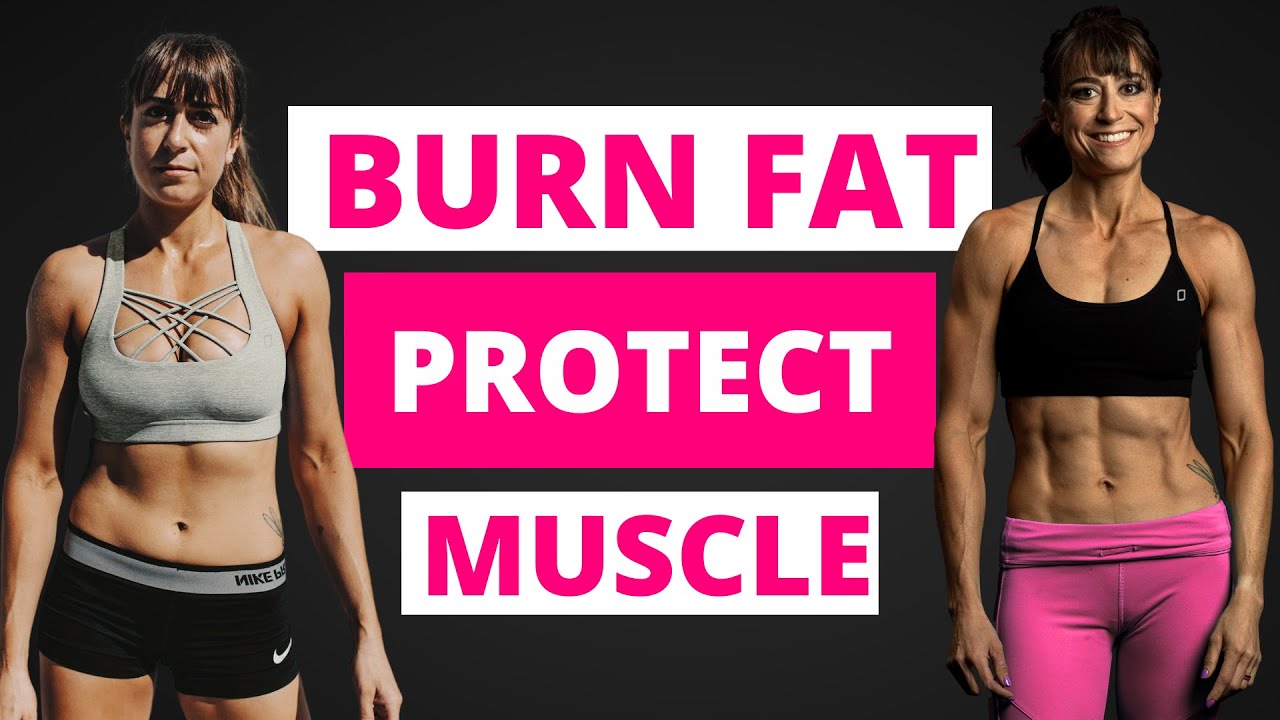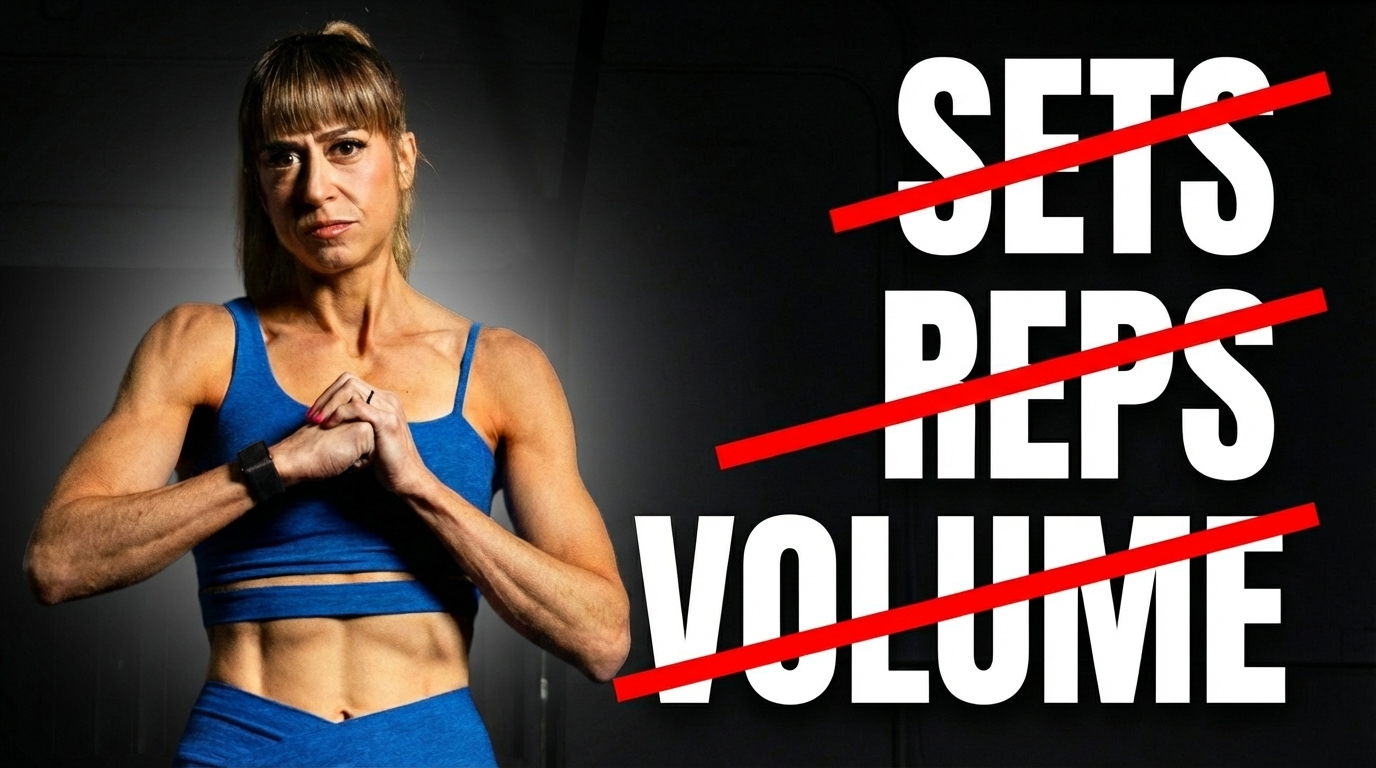I know you don’t want to hear this but…
Fat loss is a slow process.
If you’re trying to lose fat faster, you might not like the result.
And when we strive to see weight loss faster on the scale, ultimately all we’re doing is LOSING MUSCLE.
Which is generally the exact opposite of what we are trying to do.
Especially as we get older!
Because guess what?
It IS a harder process as we get older.
It’s harder to build and retain lean muscle.
It’s harder to lose fat.
Now note…I didn’t say impossible.
I said harder.
Honestly part of why it is harder is because we’ve approached losing fat in the past in the wrong way.
We’ve tried to out exercise and out diet time.
Spending hours in the gym, as we slash our calories lower isn’t what “used to work.”
It’s why we’re now stuck.
It’s why we’re now seeking to lose fat and so worried about losing our muscle.
So don’t just accept muscle loss and weight gain.

But it is time to buckle down and embrace a true lifestyle change.
That’s why I want to first go over WHY we tend to lose muscle during a fat loss phase and what we can do to protect our lean muscle while leaning down as much as possible.
And for those of you thinking…
“I only have a few pounds to lose…It shouldn’t be that hard…”
WRONG!
It’s harder and a SLOWER process to try to avoid muscle loss as you lose those last few percentages of body fat.
Because the leaner we get, the more our body wants to avoid depleting its fat stores, which are basically stored energy to make sure we are able to continue surviving.
So we can’t just slash our calories lower or train harder to try to get the scale to budge faster.
Doing so will sabotage our success.
Because muscle requires more calories to be maintained.
That’s why we often WILL lose some muscle during a weight loss or fat loss phase…
We just don’t have enough fuel coming in.
But while some muscle loss can be expected, we do to so much to prevent this from happening and even at times GAIN lean muscle while losing fat IF we focus on those fundamentals and don’t rush the process.
Because slashing your calories lower as you train harder will make your body do what it can to function off of less.
We lose muscle because it becomes an optimal source of FUEL.
It not only provides amino acids our body may feel it needs, the building blocks of protein that contribute to so many functions within our body besides just building muscle, but it also COSTS us energy to maintain.
When we eat less and burn more calories, our body finds ways to conserve energy.
Losing muscle is one of those ways as well as our brain telling us to move and fidget less.
Even bodily process such as hormone production are impacted as our body conserves energy to function as efficiently as possible off the restricted energy intake.
What our body is NOT doing as long as possible, is utilizing our fat stores.
It wants to hang onto those as fast as possible.
So when we push to see faster results on the scale, often we’ve depleted stored glycogen that our muscles hold, we’ve lost water weight because of depleting the stored glycogen and we’ve even lost muscle…
What we haven’t lost is MORE FAT from what we would have lost had we not tried to rush the process.
And often we’ve even lost LESS…
Especially as we get older.
Because our body doesn’t have the optimal hormonal environment it did when we were younger…
Not to mention previous dieting and training practices like this have already created metabolic adaptations and put us into a position where we have learned to survive off of fewer calories.
Basically if we don’t commit to dieting and training in a new way that matches what our body needs now, we’re not going to see the fat loss results we want.
But there are diet and workout changes you can make to help yourself not only reverse what’s going on but also protect that amazing lean muscle and even BUILD IT….
The thing is…
What I’m going to recommend you’re probably going to hate.
And your brain will rebel against doing it.
So let’s look at 4 tips to burn fat while protecting your muscle.
Which is to EAT MORE.
Yes, lose fat by eating more.
Especially if you’ve slashed your calories super low in the past and never retrained your body to eat more, you’ve learned how to function well off of well…Nothing.
If you’re eating under 1000 calories and not losing, it’s especially time you eat more.
And while you may think you need less as you’ve gotten older because your metabolism has slowed down, the opposite is actually true.
You need to first increase your calories to help increase your metabolic rate.
I won’t lie to you…This retraining process stinks.
And it can make you feel like you’re going BACKWARD before you go forward.
But, by eating more, you’ll have the fuel you need to help your body feel like it can let go of the stored fat.
To move more. To train hard. To support all those efficient bodily processes and restore hormonal balance.
And most importantly, you’ll build lean muscle!
With eating more, we also BURN MORE.
You burn more calories to turn that food into fuel.
So by eating more you burn more. And of course, what you eat does have an impact.
You’ll even find you may become hungrier as you eat more as your natural hunger cues return.
Now the sucky part to start…As you increase your calories, you may gain weight.
You may see some fat creep on.
But you have to go through this slow process of retraining your body to eat more BEFORE you can then create a small calorie deficit to lose.
After increasing your daily calories 50-100 and maintaining each increase for a few weeks, you may then find you have then rebuilt to a point where you start to see the scale tick down.
Or you can even then try a small deficit of 100 calories off where you’ve built to.
But the key is first learning to eat more to then have an intake where you can even create a deficit from.
Because at 800 calories?! What can you really cut!?
Now if you’re thinking, “That’s not my problem. I eat a lot and am overeating right now.”
Eating more is still key. BUT in the way of not creating an extreme deficit off of your current intake.
Don’t then dramatically slash your calories lower.
Instead just create a calorie deficit of 100-200 calories from what you’re doing.
The more we can continue to fuel, the more we support our body maintaining that lean muscle while utilizing our fat as fuel.
And to help encourage that protection of lean muscle and even avoid gaining fat as we go through that hard retraining process to start, we want to then also focus on protein.
Yup. Protein.
The macro that some people say we get too much of and others say we don’t get enough of.
And the thing is, the situation matters for what our intake should be.
The older we get…
The harder we train…The more we want to lose fat and NOT lose muscle…
The more important protein becomes.
So focus on at least 30% of your calories coming from protein to make sure you’re fueling those muscles to recover and repair while having enough protein left over for other bodily functions even while in a small calorie deficit.
And while diet is key for fat loss and even protecting our muscle, we can’t ignore how our diet and our WORKOUTS work together.
If our workouts don’t match how we’re fueling, we won’t see the results we deserve.
Yet so often our training compounds the problem of under fueling because we see our workouts just as a chance to burn more calories.
Which is why we so often turn to doing more cardio.
But if you want to protect your lean muscle, you need to focus on strength work and be SMART about how you include your cardio.
I didn’t say you couldn’t do cardio, especially if you love your long runs or rides, but you do need to be smart about how you include it.
We always need to know the cost and reward of anything we include.
Steady state long distance cardio is catabolic to muscle mass, especially when in a calorie deficit.
So if you’re turning to cardio to see results faster, you may be sabotaging yourself.
If you love your endurance sport, make sure to account for that in how you fuel and strength workout.
And no, that doesn’t mean just more carbs. Actually increasing PROTEIN is again key.
But also consider, lowering your mileage for a time to focus on one primary goal.
Remember it is easier to maintain your results once you’ve achieved them.
And if you do include cardio, prioritize your strength work FIRST.
What we do when we are freshest, we get the most benefit from.
If you do your cardio first, you’re going to be tired for your resistance workout.
Your 100% intensity simply won’t be a true 100% because you’ll be fatigued. And progressing week over week is what drives muscle growth.
So if you want to protect your muscle and lose fat, do any cardio AFTER you lift.
Even put cardio workouts after strength workouts that target those stubborn areas.
This mobilizes more fat from the areas surrounding the muscles you worked to be utilized by your cardio finisher.
Also adjust the length and intensity of those cardio sessions.
Short sprint work or even walking may be better forms of cardio for fat loss without putting you at risk for losing muscle.
Both help you burn more calories over the week to create that deficit without slashing your calories lower (aka you can eat more) while also not being catabolic to muscle.
Walking especially can be great for recovery.
And sprints can improve your conditioning and power to improve even your strength workouts while helping promote an optimal hormone environment for muscle growth!
Now, the last and probably most important thing I want to cover to help you protect your lean muscle during fat loss is something that mentally may be the hardest to do…
Step off the scale.
Yup. It’s not a workout or diet tip but it is key.
Because too often we judge fat loss based on that number on the scale changing.
And fat loss, without losing muscle, is going to mean that scale changes VERY slowly, especially the closer to your goal you get and even NOT AT ALL especially to start.
Because the scale sucks at measuring fat loss.
The faster we want the scale to change, often the more we ultimately lose muscle.
So if you want to keep yourself focused on fat loss, take measurements, progress pictures and use clothing to monitor changes.
This way you won’t sabotage yourself by working harder and going to extremes to ultimately just lose muscle and not more fat and keep yourself stuck in that horrible yo-yo dieting cycle!
Ready to dial in your diet and your workouts to work together?
Learn more about my 1:1 Online Coaching.



0 Comments